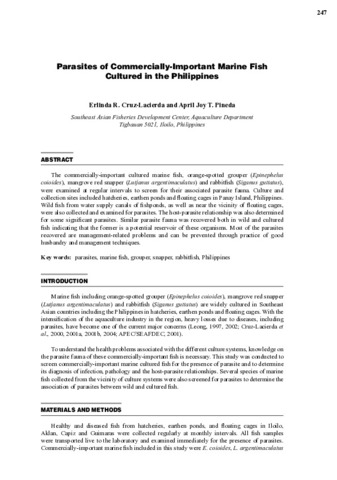Parasites of commercially-important marine fish cultured in the Philippines
| dc.contributor.author | Cruz-Lacierda, Erlinda R. | |
| dc.contributor.author | Pineda, April Joy T. | |
| dc.contributor.editor | Nagasawa, Kazuya | |
| dc.date.accessioned | 2020-07-22T02:59:05Z | |
| dc.date.available | 2020-07-22T02:59:05Z | |
| dc.date.issued | 2005-03 | |
| dc.identifier.citation | Cruz-Lacierda, E. R., & Pineda, A. J. T. (2005). Parasites of commercially-important marine fish cultured in the Philippines. In K. Nagasawa (Ed.), Recent Advances in Diagnosis and Prevention of Fish and Shrimp Diseases in Southeast Asia (pp. 247–266). Tigbauan, Iloilo, Philippines: Aquaculture Department, Southeast Asian Fisheries Development Center. | en |
| dc.identifier.isbn | 9718511732 | |
| dc.identifier.uri | http://hdl.handle.net/10862/5931 | |
| dc.description.abstract | The commercially-important cultured marine fish, orange-spotted grouper (Epinephelus coioides), mangrove red snapper (Lutjanus argentimaculatus) and rabbitfish (Siganus guttatus), were examined at regular intervals to screen for their associated parasite fauna. Culture and collection sites included hatcheries, earthen ponds and floating cages in Panay Island, Philippines. Wild fish from water supply canals of fishponds, as well as near the vicinity of floating cages, were also collected and examined for parasites. The host-parasite relationship was also determined for some significant parasites. Similar parasite fauna was recovered both in wild and cultured fish indicating that the former is a potential reservoir of these organisms. Most of the parasites recovered are management-related problems and can be prevented through practice of good husbandry and management techniques. | en |
| dc.language.iso | en | en |
| dc.publisher | Aquaculture Department, Southeast Asian Fisheries Development Center | en |
| dc.subject | groupers | en |
| dc.subject | Epinephelus coioides | en |
| dc.subject | snappers | en |
| dc.subject | Lutjanus argentimaculatus | en |
| dc.subject | Siganus guttatus | en |
| dc.subject | Philippines | en |
| dc.subject | Protozoa | en |
| dc.subject | Monogenea | en |
| dc.subject | Digenea | en |
| dc.subject | Nematoda | en |
| dc.subject | Copepoda | en |
| dc.subject | Hirudinea | en |
| dc.title | Parasites of commercially-important marine fish cultured in the Philippines | en |
| dc.type | Book chapter | en |
| dc.citation.spage | 247 | en |
| dc.citation.epage | 266 | en |
| dc.citation.bookTitle | Recent Advances in Diagnosis and Prevention of Fish and Shrimp Diseases in Southeast Asia | en |
| dc.subject.asfa | parasites | en |
| dc.subject.asfa | marine fish | en |
| dc.subject.asfa | mariculture | en |
| dc.subject.asfa | fish culture | en |
| dc.subject.asfa | aquaculture systems | en |
| dc.subject.asfa | fish diseases | en |
| dc.subject.asfa | gills | en |
| dc.subject.asfa | mortality | en |
このアイテムのファイル
このアイテムは次のコレクションに所属しています
-
Recent Advances in Diagnosis and Prevention of Fish and Shrimp Diseases in Southeast Asia [43]
Terminal Report of the Regional Fish Disease Project on “Development of Fish Disease Inspection Methodologies for Artificially-Bred Seeds” Funded by the Government of Japan Trust Fund from 2000 to 2004


 AQD Access only
AQD Access only



